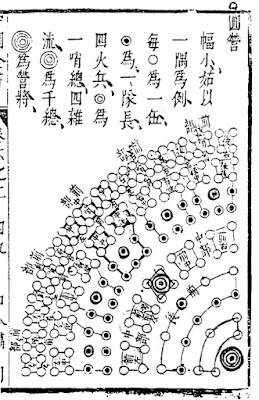Ying (營) was the largest tactical unit in the army of Xu Guang Qi (徐光啟), although administratively Da Jun (大軍) was the largest unit. A Ying consisted of five Bu (部) plus ninety-nine support personnels (on top of what Bu already had), led by a Jiang Guan (將官).
Fang Ying (方營, square regiment)
 |
| Layout of one corner of Fang Ying, from 'Xuan Lian Tiao Ge (《選練条格》)'. |
Every troops in the formation was standing five chi apart from his comrades. The formation occupied a space of two hundred eighty by two hundred eighty chi. Like its Bu-level counterpart, this number could be adjusted.
Yuan Ying (圓營, round regiment)
 |
| Layout of one corner of Yuan Ying, from 'Xuan Lian Tiao Ge (《選練条格》)'. |
Every troops in the formation was standing four chi apart from his comrades. The formation had a circumference of one thousand four hundred and forty chi and diameter of four hundred and eighty chi. It could also be adjusted when the regiment was not at its full strength.
Qu Ying (曲營), Zhi Ying (直營) and Rui Ying (銳營)
Xu Guang Qi only briefly discussed the remaining formations and did not provide any illustrations, as these formations were directly upscaled from their Bu-level counterparts.
Verdict
Xu Guang Qi's army, if successfully raised, would certainly be a force to be reckoned with. However, given the financial situation of late Ming Dynasty, one cannot help but think that Xu Guang Qi's vision of raising such an elite (and expensive) army was simply too idealistic. Even if, against all odds, he succeeded, the new army would most likely face extremely heavy attrition immediately due to rampant peasant rebellions as well as Manchu threat.
While dual role or even multi-role troops were quite common in oriental warfare, Xu Guang Qi's suggested loadout (which would put even Double Armed Man to shame) was probably too extreme and would heavily burden his troops. Worse still, even with all these heavy equipment, the Manchus still held advantage over Xu Guang Qi's army in terms of numbers, equipment (armours, cold weapons, war wagons and bow design), mobility, experience and military leadership.
Other blog posts in my De Sheng Bing series:
Xu Guang Qi's De Sheng Bing — Part 1
Xu Guang Qi's De Sheng Bing — Part 2
Xu Guang Qi's De Sheng Bing — Part 3-1
Xu Guang Qi's De Sheng Bing — Part 3-2
Xu Guang Qi's De Sheng Bing — Part 4
Xu Guang Qi's De Sheng Bing — Part 5
Amazing work. Extremely enlightening about Ming period military theories.
ReplyDelete